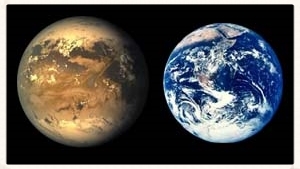Exospheres & the Parameters
Kepler 186f next to our World (credit PHL @ UPR Arecibo, NASA)
cREATING THE MUSIC
Arthur is working with exoplanet hunter Jean-Michel Desert (Boulder University/NASA/European Space Agency/CALTECH) to generate signature musical motifs for already discovered and as yet unknown exoplanets, in the ongoing quest to discover new worlds orbiting alien suns and the explore the tantalising prospect of alien life.
Because Kepler-186 (the host star) is a redder star that our sun (cooler star), then the color of sky on this planet, as well as the photosynthesis, would be at redder color than for the Earth.
Arthur and Jean-Michel have constructed a novel way to explore the diversity of new worlds (exoplanets) musically. They are using empirical measurements of three thousand plus exoplanets from NASA’s Kepler mission and other space-based and ground based-observatories, and comparing these to the properties of our own habitable Earth (i.e. establishing the possibility of life). Arthur and Jean-Michel have devised an algorithm to generate a unique 8-note melody from every exoplanet for which we have the data. As new planets are documented we can plug them into the system and get new melodies. The more earth-like the planet, the more consonant the melody - and conversely the more alien, the more extreme.
Kilanovas & Gravitational Waves
This illustration shows the gravitational waves thought to be produced by two orbiting white dwarf stars in a binary system called J0651, according to an August 2012 study.
Credit: NASA





